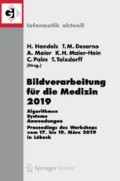Zusammenfassung
Within a clinical image analysis workflow with large data sets of patient images, the assessment, and review of automatically generated segmentation results by medical experts are time constrained. We present a software system able to inspect such quantitative results in a fast and intuitive way, potentially improving the daily repetitive review work of a research radiologist. Combining established standards with modern technologies creates a flexible environment to efficiently evaluate multiple segmentation algorithm outputs based on different metrics and visualizations and report these analysis results back to a clinical system environment. First experiments show that the time to review automatic segmentation results can be decreased by roughly 50% while the determination of the radiologist is enhanced.
Access this chapter
Tax calculation will be finalised at checkout
Purchases are for personal use only
Preview
Unable to display preview. Download preview PDF.
Literatur
Herz C, et al. dcmqi: an open source library for standardized communication of quantitative image analysis results using DICOM. Cancer Res. 2017;77.
Genereaux BW, et al. DICOMweb: background and application of the web standard for medical imaging. J Digit Imaging. 2018;31.
Monteiro EJM, et al. A DICOM viewer based on web technology. IEEE 15th Int Conf e-Health Netw, Appl Serv (Healthcom). 2013; p. 167-171.
Ellerweg R, et al. Architecture of a web-based DICOM viewer showing segmentations and simulations. IEEE 18th Int Conf e-Health Netw, Appl Serv (Healthcom). 2016; p. 1-5.
Taha AA, et al. Metrics for evaluating 3D medical image segmentation: analysis, selection, and tool. BMC Med Imaging. 2015;15.
Baudrier E, et al. Binary-image comparison with local-dissimilarity quantification. Pattern Recognit. 2008;41.
Isensee F, et al. nnU-Net: self-adapting framework for u-net-based medical image segmentation. arXivorg. 2018;.
Norajitra T, Maier-Hein KH. 3D statistical shape models incorporating landmark-wise random regression forests for omni-directional landmark detection. IEEE Trans Med Imaging. 2017; p. 155-168.
Author information
Authors and Affiliations
Corresponding author
Editor information
Editors and Affiliations
Rights and permissions
Copyright information
© 2019 Springer Fachmedien Wiesbaden GmbH, ein Teil von Springer Nature
About this paper
Cite this paper
Stein, T. et al. (2019). Efficient Web-Based Review for Automatic Segmentation of Volumetric DICOM Images. In: Handels, H., Deserno, T., Maier, A., Maier-Hein, K., Palm, C., Tolxdorff, T. (eds) Bildverarbeitung für die Medizin 2019. Informatik aktuell. Springer Vieweg, Wiesbaden. https://doi.org/10.1007/978-3-658-25326-4_33
Download citation
DOI: https://doi.org/10.1007/978-3-658-25326-4_33
Published:
Publisher Name: Springer Vieweg, Wiesbaden
Print ISBN: 978-3-658-25325-7
Online ISBN: 978-3-658-25326-4
eBook Packages: Computer Science and Engineering (German Language)

